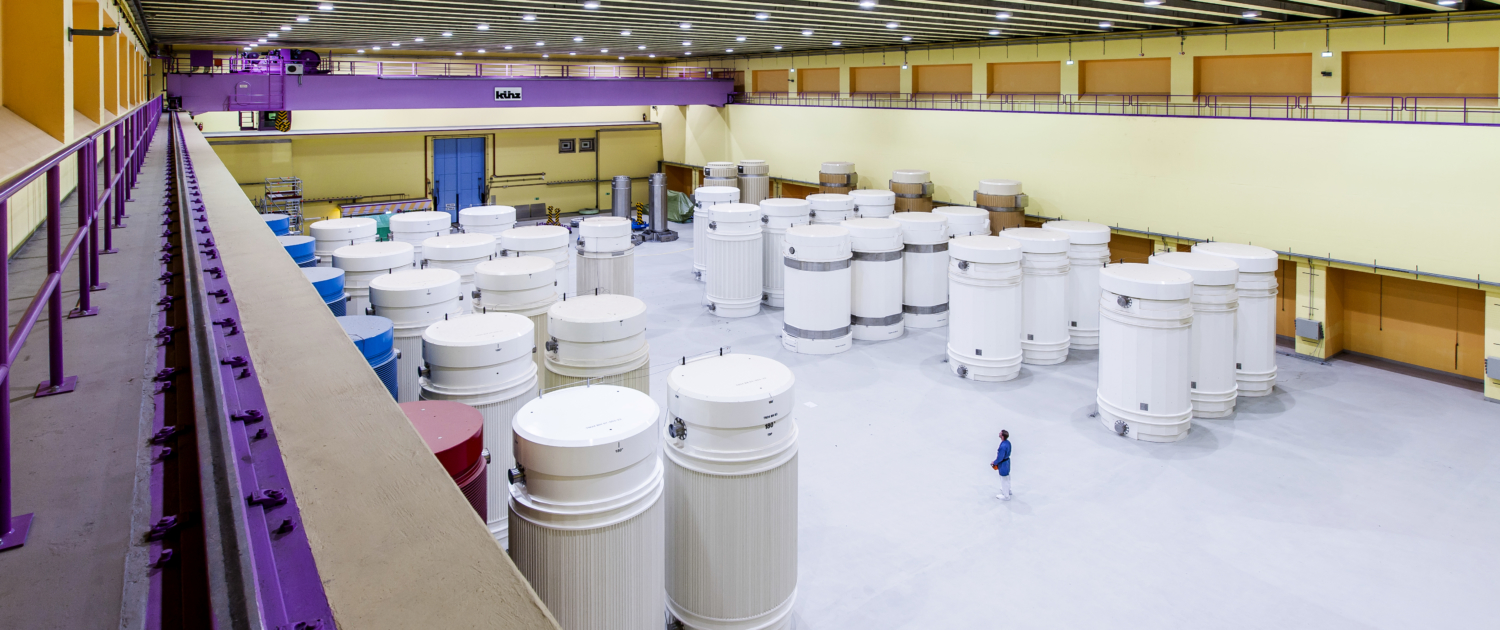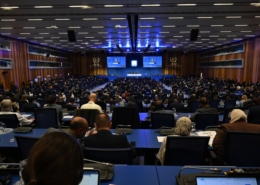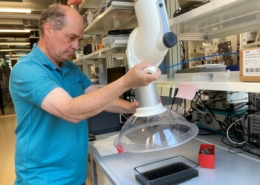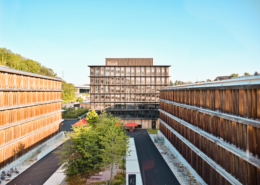20 years of Zwilag: "We're here for as long as it takes."
The interim storage facility in Würenlingen (AG) started operations 20 years ago. Radioactive material of all kinds is stored there - temporarily until a site for final disposal is realised. In 2050 this will be possible at the earliest for low- and intermediate-level waste, in 2060 for high-level waste.
Are the existing capacities at Zwilag sufficient? What has the nuclear accident in Fukushima changed in terms of safety requirements? And: Are 20 years of Zwilag a reason to celebrate? Energeiaplus asked the managing director of Zwilag, Ronald Rieck. He has managed Zwilag since mid-2016.
Energeiaplus: The first fuel elements from a nuclear power plant were delivered in July 2001. In the meantime, there are 68 storage and transport containers with approximately 3500 fuel elements in the large storage hall for highly radioactive waste. Will these capacities suffice until the deep geological repository is operational?
Ronald Rieck: Yes, the capacities that have been created in Zwilag are sufficient for the storage of all waste from all nuclear power plants that will be produced in the future. Various buildings and warehouses have been constructed since the commissioning.
The core of the Zwilag is the container storage hall, 68 metres long, 41 metres wide and almost 20 metres high. This is where the high-level waste from the reprocessing plants is stored, and where the spent fuel elements from the Swiss nuclear power plants are stored. The waste, as well as the spent fuel elements, is stored in tightly sealed transport and storage containers. When fully occupied, this hall can accommodate around 200 such containers upright.
The repository for intermediate level waste has a storage capacity for the equivalent of 384 storage containers. The storage containers are loaded with already conditioned waste packages suitable for final disposal and are placed on top of each other in the storage shafts by remote control. The storage hall is designed to shield the waste and protect it against external influences.
The storage building for low and intermediate level waste was completed between 2018 and 2020. This 98 m long, 33 m wide and almost 20 m high building with a storage capacity of a good 17'618 cubic metres has sufficient space to accommodate the corresponding waste.
Mühleberg nuclear power plant was decommissioned in December 2019. How does this affect Zwilag?
Ronald Rieck: The decommissioning of the power plant marks a certain turning point. Together with BKW, we have of course prepared for this date and carefully calculated and planned the material flows as they will arise during the decommissioning of the plant. The collaboration with Mühleberg is of course nothing new. Over the past 20 years we have periodically received low- and intermediate-level as well as high-level spent fuel elements from Mühleberg. Mühleberg is currently delivering low- and intermediate-level waste. The fuel elements that were in the reactor in the last cycle will remain in Mühleberg for the next few years.
In 1989, the voters of the Würenlingen site community said yes to the interim storage facility. In April 2000, the Zwilag was officially commissioned. It has now been in operation for 20 years. A reason to celebrate?
Ronald Rieck: Yes. We can be proud of what we have achieved so far. We set standards worldwide with our systems. In the incineration of radioactive waste, we have taken a new, state-of-the-art approach. The low- and intermediate-level waste is not incinerated in the conventional way, but thermally decomposed or melted with a plasma torch at high temperatures of up to 20'000° C. Although radioactivity cannot be reduced by this process, the volume can be reduced.
In the conditioning plant, a large number of process engineering facilities are available to treat the delivered waste - mainly general cargo and large components from the nuclear power plants. The main objective is complete decontamination up to the clearance limit, so that the waste pieces freed from radioactive materials can be recycled as conventional waste.
In the "hot cell" storage tanks can be checked or repaired if necessary. In addition, this room is also required for the inspection or for the reloading of fuel elements. The handling in the "Hot Cell" is done exclusively by remote control. Finally, I would like to emphasize one more thing: Our work is being well received. We have a good reputation in politics and among the public. We are extremely pleased about this.
In 2011 - ten years after commissioning - the nuclear accident in Fukushima occurred. Switzerland decided to phase out nuclear power and the safety requirements for nuclear installations in Switzerland increased. What adjustments did this require at Zwilag?
Ronald Rieck: As a nuclear facility, like the nuclear power plants, we have all carried out the tests and analyses ordered by the Swiss Federal Nuclear Safety Inspectorate ENSI. These showed that the Zwilag was able to withstand all extreme events with a very distinct safety margin. The nuclear energy industry in general and the Zwilag in particular have learned important lessons from Fukushima, in view of the fact that the safety of the population is the primary objective. We have subsequently implemented many measures to further improve the existing emergency protection system in specific plants. We have made major investments in earthquake protection, for example. Waste treatment is subject to strict national and international regulation and, like all nuclear power plants, is subject to supervision by ENSI and the International Atomic Energy Agency (IAEA).
What is currently the greatest challenge for the Zwilag?
Ronald Rieck: For more than half a year, the Corona pandemic has been shaping our lives. We are in the second wave and, despite the very positive development of vaccines, there is no end in sight to this difficult situation. The challenges that this poses will therefore continue to accompany our work. What I can already say today, however, is that our work in the Zwilag was not impaired at any time. We have reacted quickly and professionally. We quickly introduced the hygiene and clearance rules and splitting operations. Recently, a fever measuring station was installed in the entrance area of the Zwilag. We continue to provide our services reliably on schedule and on time. This also under difficult conditions. I am proud of the great commitment and positive spirit in the staff.
The Zwilag not only stores spent fuel rods, but also low- and medium-level radioactive material. Since this year, a new hall has also been in operation for the low-level material. Is there more and more such material?
Ronald Rieck: The dismantling of nuclear power plants will result in more and more such material, but more than 90% of it can be released at a plant and sent for normal recycling. For the remaining material that comes to us, we have successively expanded our storage capacities over the last two decades, as already mentioned.
When did the interim storage facility become obsolete? The designation indicates that the Zwilag has an expiry date
Ronald Rieck: We are there for as long as it needs us! The Zwilag is the link between waste generation and waste storage in geological formations. We will retain this function until the materials are transferred to the repository. After that, the Zwilag, like any nuclear facility, will also be dismantled.
Zwilag - briefly explained:
At the moment, the hall is filled with a good third of the highly radioactive waste. Three to four times a year, highly radioactive waste from the nuclear power plants is delivered. In total, it has space for more than 200 storage and transport containers.
The spent fuel elements are stored in massive steel casks weighing up to 140 tonnes and 6.5 metres high, which are licensed and approved by the responsible supervisory authority, the Swiss Federal Nuclear Safety Inspectorate ENSI
. They must meet the highest safety requirements and remain undamaged even in the event of fire, earthquake or an aircraft crash. After all, the safety of the population and the environment comes first. Contamination with radioactivity must not occur. During the storage period, the containers are continuously monitored.
Ronald Rieck holds a degree in mechanical engineering, specializing in nuclear energy technology. He studied at the Technical University of Zittau. He has been the managing director of Zwilag Zwischenlager Würenlingen AG since 1 July 2016.
Ronald Rieck is married and father of a grown-up son.
 Zwilag
Zwilag
 IAEA-Generalkonferenz 2024
IAEA-Generalkonferenz 2024  Benedikt VogelMehr nutzbares Biogas aus Klärschlamm
Benedikt VogelMehr nutzbares Biogas aus Klärschlamm  BFEBundesverwaltung will Vorbild sein bei der Reduktion der Umweltbelastung
BFEBundesverwaltung will Vorbild sein bei der Reduktion der Umweltbelastung  Benedikt VogelElektromobil und Pufferspeicher in einem
Benedikt VogelElektromobil und Pufferspeicher in einem 
 Shutterstock
Shutterstock Damian Poffet
Damian Poffet
Sehr interessanten Beitrag.
Mich würde Wunder nehmen, ob sich eine PV-Anlage nicht gut machen würde auf den vielen grossen und leeren Dächern… Vor allem braucht das Zwilag ja sicher sehr viel Strom.